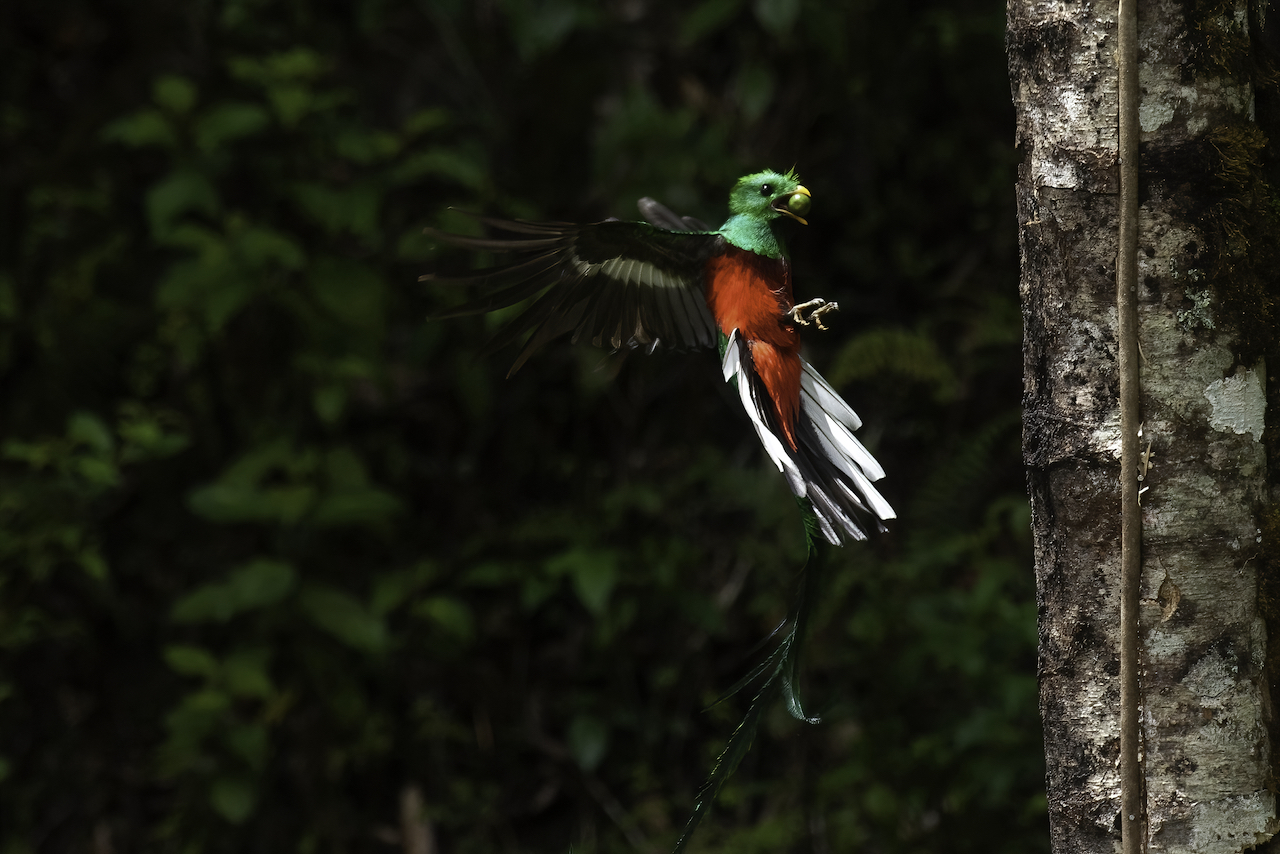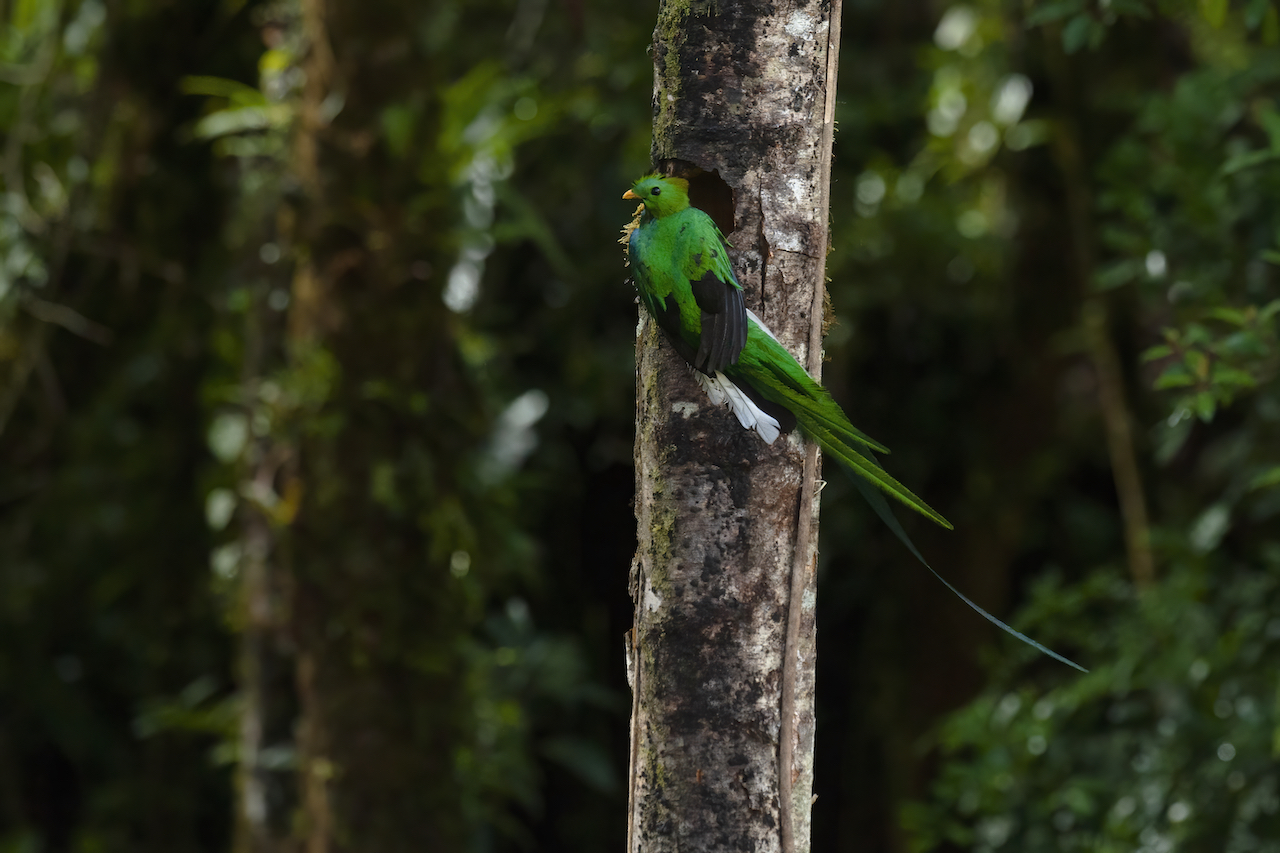Where does the Resplendent Quetzal live?
- COMMON NAME: Resplendent Quetzal
- SCIENTIFIC NAME: Pharomachrus mocinno
- TYPE: Birds
- DIET: Omnivore
- SIZE: Body: 15 to 16 inches; tail: 24 inches
- WEIGHT: 7 to 8 ounces
The resplendent quetzal is an aptly named bird that many consider among the world’s most beautiful. These vibrantly colored animals live in the mountainous, tropical forests of Central America where they eat fruit, insects, lizards, and other small creatures.
Tail Feathers and Coloring
During mating season, male quetzals grow twin tail feathers that form an amazing train up to three feet (one meter) long. Females do not have long trains, but they do share the brilliant blue, green, and red coloring of their mates. Male colors tend to be more vibrant.
Reproduction
Resplendent quetzal pairs use their powerful beaks to hollow hole nests in rotted trees or stumps. Inside, they take turns incubating two or three eggs—though males have such long tails that they sometimes stick outside the nest.
Young quetzals can fly at about three weeks of age, but males do not begin to grow their long tail plumes for three years.
Relationship With Humans
Resplendent quetzals are also known as Guatemalan quetzals, and the birds are the symbol of that nation. Guatemala also trades in currency known as the «quetzal.»
Unfortunately, these striking birds are threatened in Guatemala and elsewhere throughout their range. They are sometimes trapped for captivity or killed, but their primary threat is the disappearance of their tropical forest homes. In some areas, most notably Costa Rica’s cloud forests, protected lands preserve habitat for the birds and provide opportunities for ecotourists and eager bird watchers from around the globe.
Nesting and Breeding – The best time to see Quetzals
Quetzals rear their young in tree holes, but since their beaks are not strong enough to bore into live wood, they enlarge holes started by woodpeckers or toucans in standing dead trunks. Thin soil, heavy rainfall, strong wind, and rapid rates of decay normal in cloud forests combine with frequent mild earthquakes to make appropriate nesting trees rare and short-lived.
The optimal viewing season corresponds with the breeding season which varies from February through July over the quetzal’s range in the montane cloud forests from Southern Mexico to Panama.
In the cloud forests of Costa Rica the quetzal breeding season (and best viewing) is mid February into June or July when the wild avocado trees and other fruit from trees in the laurel family (Lauraceae) are producing. The parents chop a hole in a partially decomposed standing tree where the female lays one or two blue eggs and they both share duties incubating them.

Where to See the Resplendent Quetzal in Costa Rica?
Monteverde Cloud Forest
The most famous quetzal habitat in Costa Rica and perhaps in the world is Monteverde Cloud Forest reserve in the north central region.
At the peak of the breeding season the local birdwatching guides have identified the nesting trees. Both parents share duties in nest building, incubating the eggs and care and feeding of the young. A typical territory is only a few hundred meters across so up to a thousand visitors a day are practically guaranteed sightings.
Quetzales National Park
Two other exceptionally good places to observe the birds are both alongside the Pan American highway a few km before Cerro de la Muerte. The first, a small family owned and operated reserve at Quetzal Paradise on the northern boundary of Quetzales National Park has simple cabins and a soda plus well maintained trails to well known nesting trees.
San Gerardo de Dota
The second is at San Gerardo de Dota and the Savegre river valley. in the heart of Los Santos forest reserve along the eastern boundary of Quetzales national park. This is one of our favorite places in Costa Rica and by far the best to spot quetzals in uncrowded and beautiful surroundings (highly recommended).

Braulio Carrillo National Park
The Quetzal population in Costa Rica has benefited from the protection of water resources and one of the watersheds that supplies drinking water for the metropolitan area is just north of the international airport at the Barva Volcano sector of Braulio Carrillo national park.
Reference:


